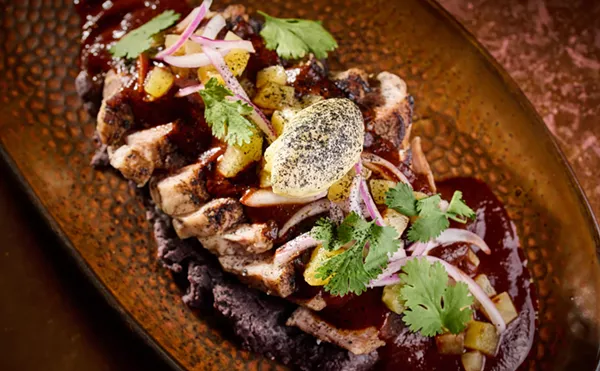As Americans, we know how to pick our nostalgia. We pluck the good, fleshy bits from the bones of our memories and leave the gristle to decay on its own. We hold onto the good stuff, and the rest floats away. After all, in the fun, heady days of a revival of a lost decade, who wants to remember the less attractive details? Everybody remembers the cute tight jeans of the '70s, but we've chosen to forget the millions of camel toes they induced.
Why then, with such a proven ability to filter out the crap of past years, is there still one gaping hole in the sieve? I'm speaking specifically of Italian restaurants. With so many innovations in décor and design, so many options in the color palette, so many new ways to approach the future or opt for only the best from the past, why do even the finest Italian places still coat their walls in that signature, sickly fake terra cotta, faux-finished Sheetrock?
Think about it: We are a people who managed to carve the ugliest parts of the '80s—the '80s!—out of our consciousness with surgical precision. We have the retro bands that make us believe 1984 was all Flock of Seagulls and no Howard Jones. Our filter has let Breakfast Club through but held Howard the Duck at bay. But when it comes to this one aesthetic, somewhere along the way a guardian of the collective psyche fell asleep at the switch and let the faux finish through, harming many a fine restaurant. I'm talking to you, Grotto. And Pulcinella. And you, Avanti in Addison.
And, sadly, I'm talking to you, Capriccio.
Mind you, it's not just a superficial thing, this faux-finish tradition. It's important. Think of it this way: Say you saw two people walking down the street. Two women. One is wearing an updated take on the '80s: Ironically pegged, slim-legged jeans; striped halter top; some wink-wink, sharp stilettos. Maybe some Madonna bangles. You'd probably think, This is a woman who has her finger on the pulse, who thinks about what she wears, who has it goin' on. You might also think she's a douche, but at least she's a douche of the naughts, a douche with style.
Then, let's say the next woman you see also has chosen to wear things from 20 years ago. Only this lady has chosen the dark side of retro: Rough synthetic fabric dress in an eye-popping primary color; bangs curled like the surf of an angry sea; shoulder pads the size of small stingrays. You'd immediately dismiss this person as irrelevant, no longer of this time, perhaps crazy. Then you'd make a Designing Women joke and walk away.
I'm not saying this to be flip—I'm laying out an argument here. And that argument is this: Some trends are meant to be forgotten, and sticking with them via default is a sign of laziness that bears its mark not just on your walls. The stamp of a faux finisher's sponge, then, is not just a brownish blotch; it is also an emblem of creative sluggishness.
This latter bit, sadly, is true of the Alpha Road Capriccio Ristorante, its walls, its atmosphere, its food.
One supposes that the bar is not set particularly high when you are located in a brand-new strip mall across the street from the Galleria, but Capriccio shoots itself in the foot the minute yours crosses its threshold. This is because they set you up. Even as your eyeballs soak in the warmed-over terra cotta/burgundy napkin/indoor fountain scene, the elegant hostess whisks you to your seat and places your napkin in your lap—a totally awkward endeavor for all parties involved, but one that speaks at least to an attempt at the proper amount of artifice, something that says, this is more than the Olive Garden. It's a weird but slightly hopeful moment.
Your spirits rise even more upon reading the menu (and here, I mean really reading; the thing's as long as Middlesex). There are the usual Italian stalwarts—lasagna and linguine, ravioli and rigatoni—and the menu covers every possible pasta contingency, providing pretty much every type of sauce and flavor combo you could imagine. There is every variety of veal and chicken in the book.
But there are also the walls, all of them, set at odd angles intended to evoke the crazy slants of Italian villas, and the walls are indeed victims of the faux finish, and all the lack of imagination that entails. Even when our server scoops our calamari from its serving tray and makes a little spine of it on the plate of each diner, it just feels like the brooch on an old Laura Ashley dress—decorative, a bit silly and completely irrelevant.
Of course, none of this would matter were the food good. We have high hopes for the oysters al forno—oysters coated in spices and a bready top, made crispy by some time in the oven—only to be informed the chef has deemed the oysters inferior. The calamari, then, is all we have, and it isn't much. Not that there is anything wrong with it; there just isn't much overly right with it.
Still clamoring for seafood, we order an entrée, the lobster ravioli, to share as another appetizer. Again, like the calamari, the flavors and textures reach a certain stasis of neither mind-blowing nor retch-inducing reaction. The lobster is present in generously sized chunks, but nothing in the preparation, from the bland cream sauce to the tender ravioli, elicits a particular response. No risk, no reward.
And no warmth, either. Even the loveliest parts of the main courses fall victim to the flat-lined atmosphere. A special, the sea bass with tomato cream sauce, benefits from flecks of delicately caramelized shallots, but the dish has no oomph, no swagger or memorable flavor. A pasta with sausage and onions is prepared just fine, but for restaurant prices? To be sure, Capriccio's prices are for the most part merciful—especially considering the plentiful servings and that each entrée comes with soup or salad—but if you pay to eat out, you pay for something you can't get at home: an atmosphere, service, maybe a special epicurean trick. Here, the pasta is cooked well, to American tastes—not quite al dente—and the sausage has a nice spicy kick, but where's the draw?
Still, there is potential. We noticed one standout, the filetto Garibaldi. It's hard to mess up a fillet, it's true, but it's also hard to create a balance between the flavor of the meat and a strong sauce. Capriccio gets it just right. The sauce is brandy-based but not overly sharp, infused with a barely perceptible tang of mustard and shallot. The side of scalloped potatoes suffices, especially when mixed with the leftover sauce.
It is a much simpler dish, relatively speaking, and perhaps as such is what Capriccio could use as a touchstone for its overstuffed menu. The eatery would be better off shelving its attempts at complex elegance and replacing them with true, straightforward character. The napkin thing, the calamari trick...they come off as dry, awkward and un-fun. Like an unstuffed cannelloni, they are a latent shell with no substance. Scale it back, Capriccio, and give us some meat; and, to paraphrase Ronald Reagan, tear down those walls.
5301 Alpha Road, 972-991-3939. Open 11 a.m.-2 p.m., 5-10 p.m. Monday-Friday, 5-10 p.m. Saturday and 11 a.m.-3 p.m., 5-8 p.m. Sunday $$-$$$












